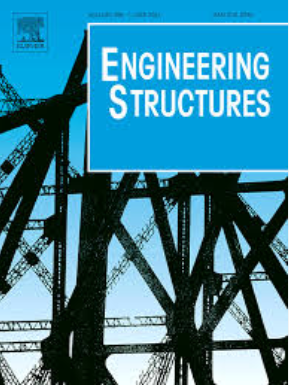计算具有单个或多个线性阻尼器的斜拉索模态阻尼比的一般半解析方法
IF 6.4
1区 工程技术
Q1 ENGINEERING, CIVIL
引用次数: 0
摘要
计算索-阻尼系统的模态阻尼比是索多模态控制设计的基础。本文提出了一种一般半解析法(GSA)来计算带有单个或多个线性阻尼器的索式阻尼器系统的模态阻尼比。本研究中考虑的电缆阻尼器包括任何一种无源线性阻尼器及其组合。首先在频域给出了线性阻尼力的广义表达式。然后,分别推导了考虑垂度效应和不考虑斜拉索-阻尼系统的一般复特征值方程。模态阻尼比可以通过数值求解复特征值方程来确定。以中国观音寺长江大桥609m斜拉索为例,考虑单阻尼器和多阻尼器两种情况,验证了该方法的准确性。数值结果表明,与基于有限差分法的特征值分析法计算的模态阻尼比相比,所提出的半解析方法得到的前70阶模态阻尼比更为精确。对比研究证实了GSA比经典的渐近解和有限差分法具有更好的适用范围。本研究建立了一种高效、准确的索-阻尼系统模态阻尼比计算方法,这对斜拉桥索的多模态控制具有重要意义。本文章由计算机程序翻译,如有差异,请以英文原文为准。
A general semi-analytical approach for calculating modal damping ratios of a stay cable with single or multiple linear dampers
Calculating the modal damping ratios of a cable-damper system is fundamental in the design of cable multimode control. This paper proposes a general semi-analytical approach (GSA) for calculating the modal damping ratios of a cable-damper system equipped with single or multiple linear dampers. The cable dampers considered in this study include any kind of passive linear dampers and their combination. A generalized expression of linear damper forces is first given in the frequency domain. Then, we derive general complex eigenvalue equations for cable-damper systems, considering or not considering the sag effect and cable inclination, respectively. The modal damping ratios can be determined by numerically solving the complex eigenvalue equations. The accuracy of the proposed approach is validated using the 609m-long stay cable of the Guanyinsi Yangtze River Bridge in China, considering both single-damper and multiple-damper cases. Numerical results demonstrate that the proposed semi-analytical approach yields quite accurate modal damping ratios of the first 70 modes compared with those computed by the eigenvalue analysis based on the finite difference method. Comparative studies confirm the GSA’s superior application scope over classical asymptotic solutions and the finite difference method. This study establishes an efficient and accurate approach for calculating modal damping ratios of a cable-damper system, which is critical for cable multimode control of cable-stayed bridges.
求助全文
通过发布文献求助,成功后即可免费获取论文全文。
去求助
来源期刊

Engineering Structures
工程技术-工程:土木
CiteScore
10.20
自引率
14.50%
发文量
1385
审稿时长
67 days
期刊介绍:
Engineering Structures provides a forum for a broad blend of scientific and technical papers to reflect the evolving needs of the structural engineering and structural mechanics communities. Particularly welcome are contributions dealing with applications of structural engineering and mechanics principles in all areas of technology. The journal aspires to a broad and integrated coverage of the effects of dynamic loadings and of the modelling techniques whereby the structural response to these loadings may be computed.
The scope of Engineering Structures encompasses, but is not restricted to, the following areas: infrastructure engineering; earthquake engineering; structure-fluid-soil interaction; wind engineering; fire engineering; blast engineering; structural reliability/stability; life assessment/integrity; structural health monitoring; multi-hazard engineering; structural dynamics; optimization; expert systems; experimental modelling; performance-based design; multiscale analysis; value engineering.
Topics of interest include: tall buildings; innovative structures; environmentally responsive structures; bridges; stadiums; commercial and public buildings; transmission towers; television and telecommunication masts; foldable structures; cooling towers; plates and shells; suspension structures; protective structures; smart structures; nuclear reactors; dams; pressure vessels; pipelines; tunnels.
Engineering Structures also publishes review articles, short communications and discussions, book reviews, and a diary on international events related to any aspect of structural engineering.
 求助内容:
求助内容: 应助结果提醒方式:
应助结果提醒方式:


